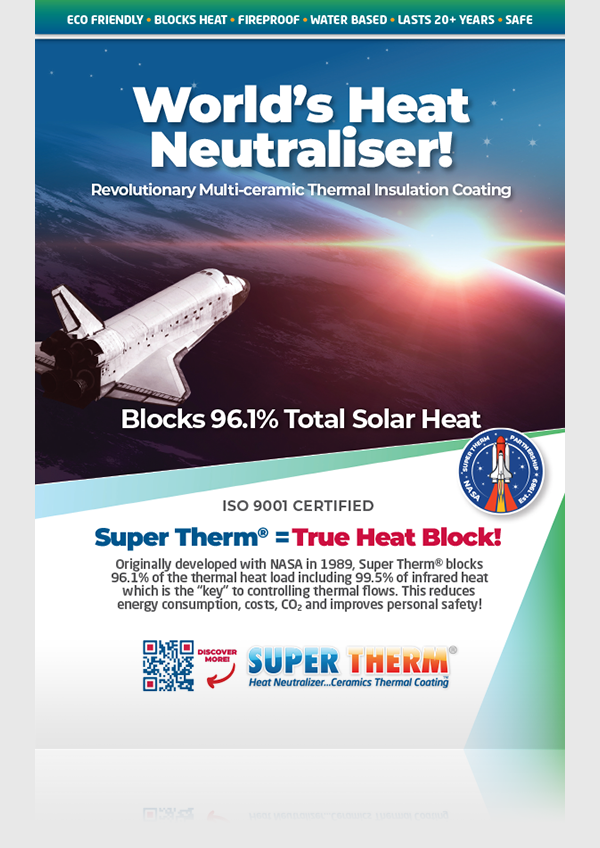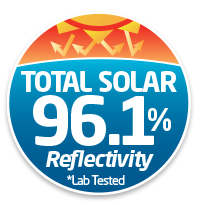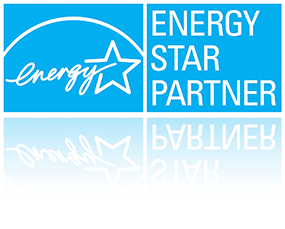Comparing Super Therm® vs. a Competitor’s Single Ceramic Technology
Both Super Therm® and a competitor’s single ceramic particle technology present themselves as advanced insulation coatings designed to combat extreme heat and improve energy efficiency. However, the core difference is in how each product addresses heat transfer and thermal protection and their proven results.
1. Core Technology: Heat Block vs. Heat Slowdown
Super Therm® (Proven NASA Technology)
✔ Stops heat before it enters—blocks all three solar radiation waves (UV, visible, and infrared).
✔ Multi-ceramic formula engineered to block, reflect and dissipate heat, not absorb or transfer it.
✔ Tested at multiple temperatures (25°C, 50°C, 75°C, 100°C) using ASTM standards, proving consistent performance in all climates.
✔ DOE, NASA, and ASTM backed, used in real-world applications for over 35 years.
Competitor’s Single Ceramic Technology
✔ Focuses on slowing heat transfer rather than preventing heat load.
✔ Relies on one ceramic particle type vs. Super Therm‘s multi-ceramic blend.
✔ Uses high reflectivity, emissivity, and low thermal conductivity but does not eliminate heat load.
✔ Claims energy savings based on a single case study, rather than global, long-term use.
2. Testing & Real-World Validation
Super Therm®: Proven Across Decades and Continents
- ASTM Testing at Four Temperatures (25°C, 50°C, 75°C, 100°C)—performance consistency across global climate conditions.
- DOE Weatherization Assistance Program (WAP) testing—verified as a legitimate energy-saving solution.
- Florida Department of Energy validation—proven in real-world trials in Florida, Denver, and Texas.
- Used on 10.2 million+ square metres in Japan over 35 years, demonstrating real-world durability.
Competitor’s Single Ceramic Technology: Limited Data and Case Studies
- Highlights a single study from a Fortune 500 retailer showing a good HVAC reduction, but lacks multiple, independent, long-term validations.
- No mention of multi-temperature ASTM testing—questioning how it performs across diverse climates.
- No DOE or NASA validation—a key difference in credibility.
3. Thickness & Performance Consistency
Super Therm®: Thin but Incredibly Effective
- Applied at only 250 microns—a credit card’s thickness.
- Blocks 96.1% of total solar heat without requiring additional thickness.
- No compaction, no moisture retention, no loss of performance over time.
Competitor’s Single Ceramic Technology: Relies on Thickness to Maintain Performance
- Applied at thicknesses of 1mm means more product
- Claims to slow heat transfer, meaning it still allows heat to penetrate—just at a reduced rate.
- As ambient temperatures increase, additional thickness may be needed (similar to R-value-based materials).
4. R-Value vs. Heat Block Technology
Super Therm®: Beyond R-Value—No Heat Load, No Heat Transfer
- Rejects the need for R-value calculations because it blocks the initial heat load.
- R-value insulation works by absorbing heat until full (heat flux)—Super Therm® prevents absorption altogether.
- Performs consistently across all climates, unlike R-value materials which are tested at a single temperature (75°F/23.9°C).
Competitor’s Single Ceramic Technology: Still Playing by R-Value Rules
- Emphasizes slowing heat transfer through conduction, which means heat still enters the material.
- Does not mention resistance to heat flux, suggesting its performance is limited as temperatures increase.
- Still requires thickness adjustments for extreme conditions—the very limitation that Super Therm® eliminates.
5. Real-World Adoption & Industry Trust
Super Therm®: Used by NASA, DOE, and Global Industries
✔ NASA co-developed technology with J.E. Pritchett.
✔ DOE-tested and verified for energy efficiency.
✔ Military-grade applications and commercial adoption worldwide.
✔ Over 10 million sq. meters in Japan alone, used on major infrastructure.
Competitor’s Ceramic Technology: Limited Industry Recognition
✔ Featured in Paint & Coatings Industry Magazine, but lacks large-scale global adoption.
✔ No mention of NASA, DOE, or military testing.
✔ No long-term usage data—just case studies.
Final Verdict: Why Super Therm® is the Superior Insulation Coating
| Feature | Super Therm® Heat Block | Competitor’s Single Ceramic |
|---|---|---|
| Core Technology | Multi-ceramic heat block technology | Single-particle ceramic thermal coating |
| Functionality | Blocks heat before it loads | Slows heat transfer through conduction |
| Independent Testing | ASTM tested at four temperatures (25°C to 100°C) | No multi-temperature ASTM data provided |
| Validation | NASA, DOE, ASTM, Military, 32+ years in use | PCI Magazine feature, Fortune 500 case study |
| Thickness Required | 10 mils (250 microns) | 38 mils (1000 microns) |
| Performance in All Climates | Consistent across global conditions | No proof of multi-climate consistency |
| Long-Term Use Cases | Used on 10.2M+ sq. meters in Japan alone | No mention of global large-scale applications |
The Difference is Clear
✔ Super Therm® blocks heat before it enters—single ceramic only slows it down.
✔ Super Therm® has been NASA & DOE validated for 35+ years—single ceramic is a new, unproven technology.
✔ Super Therm® maintains performance at any temperature—single ceramic effectiveness remains unclear but other coatings deploy the same technology.
If you want the only thin-coat insulation coating in the world backed by NASA, DOE, and ASTM, there’s only one choice:









